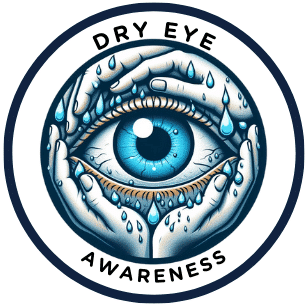
Having experienced the challenges of maintaining eye health during travel firsthand, I know it’s not something to take lightly. Dry eyes are a common complaint among travelers, especially during air travel. Did you know that the humidity in airplane cabins is often less than half of what we consider comfortable? This low humidity can lead to increased tear evaporation, which might leave your eyes feeling like they’ve been through a desert.
Beyond the cabin conditions, the features designed for personal comfort in your seat can also contribute to eye dryness. A blast from the overhead air vent might seem refreshing, but it can actually wick moisture away from your eyes. And if you’re planning to catch up on a good book or watch a movie, you might not realize that these activities can cause you to blink less frequently, further reducing the hydration in your eyes.
The journey doesn’t stop with the flight; changes in climate upon arrival can further affect your eyes. A shift from a humid hometown to a dry destination can alter your tear film composition, potentially leading to irritation and even allergic conjunctivitis. This is why discussing any pre-existing eye conditions with your healthcare provider before you travel is essential.
With all this in mind, it’s important to strategize for your eye health before you even pack your bags. Proper hydration is key, both inside and out. In the next section, I’ll walk you through some practical pre-travel preparations that can help you maintain comfortable, hydrated eyes throughout your trip and beyond.
Pre-Travel Preparation for Optimal Eye Comfort

I understand how dry, uncomfortable eyes can cast a cloud over the excitement of travel. It’s why I emphasize pre-trip strategies that lay the foundation for optimal eye health.
Hydration is the ACHILLES’ HEEL of many travelers. I make it a routine to increase my water intake before, during, and after a flight. It’s not just about quenching thirst, it’s about keeping those tear ducts well supplied.
If you’re someone who switches between glasses and contact lenses, consider this your friendly reminder: opt for glasses when you’re flying. This simple switch has been a game-changer for keeping my eyes from feeling like a desert.
Proactive use of hydrating eye drops is part of my travel toolkit. A few well-timed applications provide temporary relief and a reprieve from the cabin’s dry air.
My advice includes ensuring a sturdy chat with your healthcare provider before traveling. They can guide you on managing dry eye symptoms and make personalized recommendations based on your eye health history.
In-Flight Strategies to Combat Dryness

When you’re flying, combating eye dryness isn’t just about what you do before you step on the plane it’s also about the actions you take once you’re in the air. Keeping your eyes comfortable during a flight might seem challenging, but with these strategies in hand, you can reduce discomfort effectively.
Why pick glasses over contacts while cruising at altitude? Contact lenses can aggravate eye dryness as they draw moisture from your eyes. On a plane, this is magnified due to the already dry environment. Glasses, on the other hand, retain the moisture your eyes desperately need, protecting them from the harsh cabin air.
Sleep masks (#ad) are a travel necessity I never fly without (As an Amazon Associate I earn from qualifying purchases). They do more than just block out light; they create a moisture barrier around your eyes, preventing them from succumbing to the dry cabin air while you rest. Think of it as a mini-humidifier for your eyes simple yet effective.
Not all face masks are created equal, and when it comes to your eyes, fit matters. A poorly fitted mask can direct a stream of air upwards, drying out your eyes. To avoid this, ensure that your face mask fits snugly across the bridge of your nose. That way, the air is filtered downwards, away from your eyes, keeping them from getting dry.
Having control over the air vent is a small but significant way to influence your eye comfort. Fully opened vents blast air directly at you, hastening moisture evaporation from your eyes. I recommend adjusting the vent to ensure a gentle flow of air that doesn’t hit your face. Keeping the vent partially open or directing it away from you can provide a balance between staying cool and keeping your eyes moist.
Long-Term Solutions and Personal Insights for Managing Dry Eyes
Comprehensive support for dry eyes goes beyond quick fixes. The journey to comfortable vision, especially for those who travel frequently, may require exploring several treatment options.
For instance, artificial tears (#ad) can offer immediate relief, while options like warm compresses (#ad) help stimulate natural tear production. Punctal plugs, which block tear drainage, can provide a more sustained solution.
Other advanced treatments, such as topical steroids for inflammation and intense pulse light therapy, address underlying conditions which contribute to dryness.
When considering systemic remedies, it’s worth noting that medications like antihistamines and decongestants may decrease tear production. A delicate balance between managing symptoms and maintaining eye hydration is essential.
On long-haul flights, a combination approach often will yield the best results. Remove your contact lenses and use eye gel drops (#ad) for lasting hydration. If you experience severe dry eye symptoms after you reach your destination, I recommend you use a dry eye ointment (#ad) at bedtime for rapid improvement.
Ultimately, individuals may consider permanent fixes such as laser eye surgery. This can be a life-changing step for those struggling with persistent dry eye symptoms who are also frequent travelers.
Remember, every person’s eyes are unique, and the best plan is to work in close consultation with an eye care specialist to craft a tailored strategy that ensures long-term comfort and eye health, regardless of where your travels take you.
